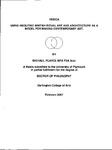Vesica: using Neolithic British ritual art and architecture as a model for making contemporary art
| dc.contributor.author | Pearce, Michael | |
| dc.contributor.other | Faculty of Arts, Humanities and Business | en_US |
| dc.date.accessioned | 2013-11-04T12:57:02Z | |
| dc.date.available | 2013-11-04T12:57:02Z | |
| dc.date.issued | 2007 | |
| dc.identifier | NOT AVAILABLE | en_US |
| dc.identifier.uri | http://hdl.handle.net/10026.1/2574 | |
| dc.description | Merged with duplicate record 10026.1/646 on 08.03.2017 by CS (TIS) | |
| dc.description.abstract |
Can the creative practices of British Neolithic art and architecture be used in the making of contemporary art? This dissertation describes my practice making works of art based on the Neolithic model, presented in a gallery setting and occasionally in the landscape. The creative process is grounded on research into prehistoric British art and ritual architecture and records my process of understanding the work of ancient Britons as a framework for the concurrent process of making new objects for display. Without extensive research and direct experience of the Neolithic art and architecture I would not have been able to create the responsive work that has grown from it. I visited dozens of sites in England, Scotland, and Ireland, immersing myself as much as possible within them, on them and around them; I breathed the damp air and sheltered from the rain under their roofs; I ate in them, I touched, measured and aligned them. I visited them in daylight and at night; summer and winter; on solstices and ordinary days; sometimes by car but mostly on foot. I read copious texts by academic archaeologists in my effort to get into the minds of the people who made these places and got to know the archaeological scene well enough to deliver a paper at the Theoretical Archaeology Group Conference in 2005, taking questions from distinguished Professors Julian Thomas and Mike Parker Pearson. My research included the types of space that remain and explores patterns that exist within the structures, interpreting, based on the archaeology, how the places Neolithic people made might have been used in ritual; in addition it includes an exploration of the decoration and phenomena of the spaces. The process of understanding the Neolithic shaped and transformed my creative practice and profoundly affected my practice of making art and introducing a shamanic theme into the way I share it. The work I make is therefore a response to the ancient practices of the men and women, a collection of objects that a Neolithic artist might make today. Finally the thesis is concerned with identifying three strategies used by contemporary artists; Reconstructing, "Artefacting", and Responding to Neolithic spaces, then documents how these three strategies are used as models in the creation of the practical work that corresponds with the written work. Issues of presentation are explored at some length, born of the dilemmas I experienced when making decisions of where and how to show people what I had made. | en_US |
| dc.description.sponsorship | Dartington College of Arts | |
| dc.language.iso | en | en_US |
| dc.publisher | University of Plymouth | en_US |
| dc.title | Vesica: using Neolithic British ritual art and architecture as a model for making contemporary art | en_US |
| dc.type | Thesis | |
| plymouth.version | Full version: final and full version as approved by the examiners at the time of the award of your degree | en_US |
| dc.identifier.doi | http://dx.doi.org/10.24382/1572 |
Files in this item
This item appears in the following Collection(s)
-
01 Research Theses Main Collection
Research Theses Main


